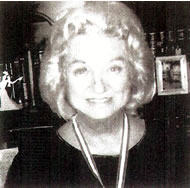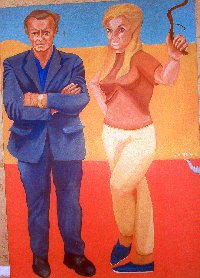|
|
VFA HONORS JUNE BLUM
ON THE OCCASION OF HER EXHIBITION

"The Red Dress" will be featured
in June Blum's exhibition at the
Long Island University's
Renwick Gallery Showcase,
Brooklyn Campus,
January 24 through
February 25, 2011.
Book (On my black and whites)
available at Amazon.com and bluenotebooks.com
|
JUNE BLUM - ARTIST OF THE MONTH
JANUARY 2011
PAINTER, SCULPTOR, CURATOR OF FIRST IN-HOUSE WOMEN ARTISTS EXHIBITION, ACTIVIST FOR WOMEN IN ART
 I was born June Druiett in 1929 in Maspeth,
New York, a town with trolley tracks running through its main cobblestone street. Life passed by my house as I
watched them from our bedroom window and our enclosed porch. But after my grandfather died, my two sisters and
I moved with my mother and father into my grandmother's house. I was born June Druiett in 1929 in Maspeth,
New York, a town with trolley tracks running through its main cobblestone street. Life passed by my house as I
watched them from our bedroom window and our enclosed porch. But after my grandfather died, my two sisters and
I moved with my mother and father into my grandmother's house.
I recall my mother receiving a washing machine (I had never thought about how the clothes got cleaned). My dad
purchased a television, which became my connection to the outside world. A dance show on TV excited my long-time
love of dance and dancing. In 1985 this love helped me out of a deep low after my husband, Maurice, died.
We were five women in a house after my father died in 1941. The war had broken out three days before and my mother
worked for the war effort. Although still young and beautiful, she never showed any desire to marry again.
From early on I was interested in dancing, but had none in dating. As a teenager I was allowed to go to an afternoon
dance at the Ascension church where I never refused a request to dance and never sat down for the whole two hours.
Beyond that I had little contact with the opposite sex.
In general I gravitated toward female adults--my teachers at school were mostly female--as they had vast experiences
and knowledge. I was too young and immature for male relationships, and besides, had a very strict mother who kept
her children together and always in her sight.
Schooling in those days was sewing, cooking (which I hated), copperplate and handbag making, and art. I played
the clarinet, was in the school orchestra, and in a school play, "The Student Prince.” My mother put together
a group of area musicians my age and we played for other kids in the neighborhood who liked to dance. My younger
sister and I played the clarinet and my older sister played the saxophone. As I watched the kids dancing, I realized
this was not for me, as I wanted to be the one dancing.
In 1956 I met Maurice Blum through
friends, and we were soon married.
 |
In 1956 I met Maurice Blum through friends, and we were soon married. Maurice was a businessman and photographer.
He attended all the demonstrations and meetings and photographed the activities-- at least those where men were
allowed--and was a constant support of everything I was doing.
I studied at Brooklyn College, Pratt Graphic Art Center, The New School for Social Research, Art Students League,
The Crafts Students League, and The Brooklyn Museum Art School. In the 1960’s I was invited to join the National
Association of Women Artists, was chairperson and exhibited art exhibitions nationally and internationally.
In 1968-9 I wrote, directed and produced "The Female President." It was an idea whose time had come,
particularly after Betty Friedan's "The Feminist Mystique" and all the publicity about her and feminism.
Although publicity was scant for my play, the attendance was great.
In 1971 I was appointed Curator of Contemporary Art of the Suffolk Museum at the Museums of Stony Brook, New York.
After trying to find female artists for a figure exhibition, my first experience proved to me that there was discrimination
against women artists in the art world. I then curated an all-woman artists exhibition ok'd by the female director,
Jane des Grange, with her blessing. Titled "Unmanly Art," this showing of 56 women artists was the first
in-house museum-curated exhibition of women artists in the United States.
Subsequent meetings, demonstrations and events fortified my underlying feeling that women were kept out of mainstream
art, galleries and funding. I had alliances with women who put together panels and speakouts. Asked to talk at
the Brooklyn Museum I met many women artists, critics and writers who felt the same about the lack of opportunity
to exhibit their work. I met Pat Mainardi and Irene Peslikis at editorial meetings for the publication "Women
and Art" at Cindy Nemser's house in Brooklyn and wrote articles for Cindy's Feminist Art Journal. In my series
of painting women artists I did paintings of Pat and Cindy.
With the new feminist group, I supported demonstrations at the Whitney Museum and galleries protesting the lack
of work by women artists. I was assigned to the OK Harris Gallery in Soho. After group meetings with the directors
at the Brooklyn Museum in 1971, I came up with the idea for an original selection concept, and in 1975 coordinated
the first all-women drawing exhibit there. Titled "Works on Paper/Women Artists," it gave entry to a
New York City museum to 141 women artists.
Invited to do a painting for "The Sister Chapel" project, a proposed moveable installation where 13 women
artists were asked to choose a woman of heroic quality, I chose Betty Friedan and titled my work "Betty Friedan
as the Prophet."
After many calls and finally getting acceptance, I met Ms. Friedan at her apartment across from Lincoln Center,
an unforgettable experience. Not only was I impressed by the enormity of the challenge to paint this great woman,
but meeting this monumental personality was like being run over by a steamroller, and it was a challenge. Also
it wasn’t easy, as she was constantly moving about, answering phone calls or talking with her assistant.
Over a period of six sittings I produced seven studies, some drawings and many photographs of her. After the sessions
were over, I created the 9' x 5' painting in my Brooklyn studio and then did another painting, now in the collection
of Muriel Fox. I also did several drawings and took numerous photographs. When Ms. Friedan had to go out of town
she loaned me the dress she had posed in, which I put on to get the correct hanging of the fabric in order to continue
doing conceptual documentations.
Maurice took photos of me which I used to create my artist's books titled "Transformations”; "June Blum
as Betty Friedan"; " The Metamorphosis of June Blum"; and "On Painting Betty Friedan."
In 1977 Nelleke Nix, director of the NN Gallery in Seattle, WA, exhibited my small portraits of Betty and the June
Blum Documentations. I could have gone on painting Betty's most interesting face and personality forever, but other
projects took over. 
I was founder, director and organizer of the Brooklyn Women Artists and Women Artists Living in Brooklyn, exhibiting
groups that gave exposure to women artists’ work. At that time--it was during the 70's--I was the only one doing
this. Long Island University's Brooklyn campuses gave shows to professional artists, including my groups. The Brooklyn
Museum had a fine art school and agreed to a national women's drawing exhibition. These events kick-started the
women's art movement in New York City and around the country.
The first showing of my work had been in1964 at Brooklyn’s Hicks Street Gallery. In 1980 we moved to Cocoa Beach,
FL, where I started the East Central Florida chapter Women's Caucus for Art. I was on the Brevard's Commission
on Women and did a visual documentation on Cocoa Beach's history for its seventy-fifth anniversary. One of its
features was my visualization of Capt. Irene Wirtschafter, a Navy pilot and the first woman to land on an aircraft
carrier during World War II. Because of this, I received a letter from the National Museum of Women in the Arts
acknowledging my contributions to art. In addition to my curatorial work at the Suffolk Museum, I curated exhibits
around the country, creating women artists’ exhibitions and continuing my support of women artists.
One day, as I was walking in to an opening at the Whitney I overheard the staff saying "There's June Blum!"
which befuddled me, as Salvador Dali was there. Later I was told by Alice Neel that the painting she had done of
me had been loaned to the Whitney.
Later, as I was going over Maurice's photos of that opening I noticed he had captured Salvador Dali and his companion.
Maurice never hesitated to photograph anyone and I had no objections, particularly to his photos of the women's
movement. I encouraged him in his photography and he encouraged me in my career. Some of his works included Kate
Millett's art, Senator Robert Kennedy leaving after a luncheon talk, many events and demonstrations, and always
my art. I’m proud of the work I’ve done, and proudest of the Veteran Feminists of America medal I was awarded in
2003.
A most recent painting of mine was influenced by the dress Betty Friedan had loaned me. Although abstracted in
black and white with red, "The Red Dress" still stimulates my creativity, as Betty's spirit continues
to inspire, and will inspire generations of women in the future.
Book (On my black and whites) available
at Amazon.com and bluenotebooks.com
Contact June Blum: juneblumart@msn.com
Comments to Jacqui Ceballos: jcvfa@aol.com
Back to VFA Fabulous Feminists
Table of Contents |
|